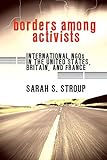Borders among Activists : International NGOs in the United States, Britain, and France / Sarah S. Stroup.
Material type: TextPublisher: Ithaca, NY : Cornell University Press, [2012]Copyright date: ©2012Description: 1 online resource (208 p.) : 4 tables, 4 charts/graphsContent type:
TextPublisher: Ithaca, NY : Cornell University Press, [2012]Copyright date: ©2012Description: 1 online resource (208 p.) : 4 tables, 4 charts/graphsContent type: - 9780801450730
- 9780801464256
- 341.2 23
- JZ4841 .S79 2016
- online - DeGruyter
- Issued also in print.
| Item type | Current library | Call number | URL | Status | Notes | Barcode | |
|---|---|---|---|---|---|---|---|
 eBook
eBook
|
Biblioteca "Angelicum" Pont. Univ. S.Tommaso d'Aquino Nuvola online | online - DeGruyter (Browse shelf(Opens below)) | Online access | Not for loan (Accesso limitato) | Accesso per gli utenti autorizzati / Access for authorized users | (dgr)9780801464256 |
Browsing Biblioteca "Angelicum" Pont. Univ. S.Tommaso d'Aquino shelves, Shelving location: Nuvola online Close shelf browser (Hides shelf browser)

|

|

|

|

|

|

|
||
| online - DeGruyter She Hath Been Reading : Women and Shakespeare Clubs in America / | online - DeGruyter Sanctified Landscape : Writers, Artists, and the Hudson River Valley, 1820-1909 / | online - DeGruyter The Poor and the Perfect : The Rise of Learning in the Franciscan Order, 1209–1310 / | online - DeGruyter Borders among Activists : International NGOs in the United States, Britain, and France / | online - DeGruyter Francis of Assisi : A New Biography / | online - DeGruyter Under the Surface : Fracking, Fortunes, and the Fate of the Marcellus Shale / | online - DeGruyter Housing the New Russia / |
Frontmatter -- Contents -- Acknowledgments -- List of Abbreviations -- Introduction: Where Have All the Borders Gone? -- 1. Varieties of Activism in Three Countries -- 2. Humanitarian INGOs -- 3. Human Rights INGOs -- 4. Reconciling Global and Local -- Appendix A: Case Selection -- Appendix B: Interviews Conducted -- References -- Index
restricted access online access with authorization star
http://purl.org/coar/access_right/c_16ec
In Borders among Activists, Sarah S. Stroup challenges the notion that political activism has gone beyond borders and created a global or transnational civil society. Instead, at the most globally active, purportedly cosmopolitan groups in the world-international nongovernmental organizations (INGOs)-organizational practices are deeply tied to national environments, creating great diversity in the way these groups organize themselves, engage in advocacy, and deliver services.Stroup offers detailed profiles of these "varieties of activism" in the United States, Britain, and France. These three countries are the most popular bases for INGOs, but each provides a very different environment for charitable organizations due to differences in legal regulations, political opportunities, resources, and patterns of social networks. Stroup's comparisons of leading American, British, and French INGOs-Care, Oxfam, Médecins sans Frontières, Human Rights Watch, Amnesty International, and FIDH-reveal strong national patterns in INGO practices, including advocacy, fund-raising, and professionalization. These differences are quite pronounced among INGOs in the humanitarian relief sector, and are observable, though less marked, among human rights INGOs.Stroup finds that national origin helps account for variation in the "transnational advocacy networks" that have received so much attention in international relations. For practitioners, national origin offers an alternative explanation for the frequently lamented failures of INGOs in the field: INGOs are not inherently dysfunctional, but instead remain disconnected because of their strong roots in very different national environments.
Issued also in print.
Mode of access: Internet via World Wide Web.
In English.
Description based on online resource; title from PDF title page (publisher's Web site, viewed 02. Mrz 2022)


